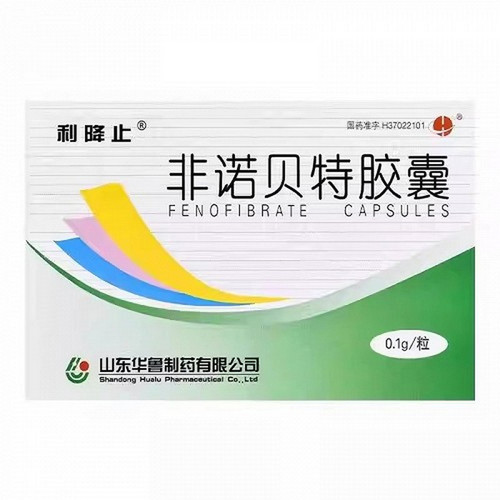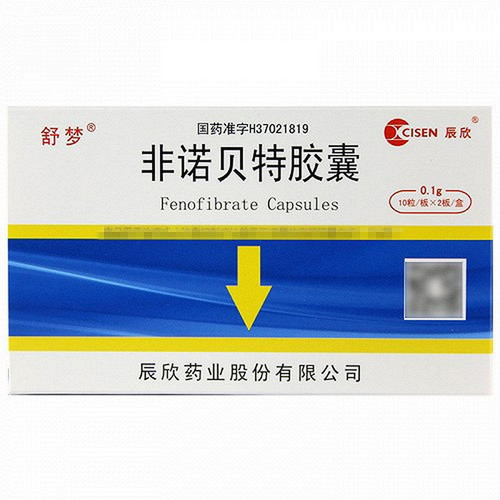Product Overview
[Drug Name]
Generic Name: Fenofibrate Capsules
Trade Name: Xianqiang Fenofibrate Capsules 0.1g*12 Capsules
[Main Ingredients]
The active ingredient of this product is fenofibrate.
[Properties]
This product is a capsule containing a white or off-white crystalline powder.
[Indications/Main Functions]
This product is used to treat hyperlipidemia in adults who have not responded well to dietary control therapy. It is more effective in lowering triglycerides and mixed hyperlipidemia than cholesterol. However, fenofibrate capsules (I) cannot completely replace dietary control therapy and should only be used as an adjunctive treatment in addition to dietary control.
[Specifications]
0.1g*12 Capsules
[Dosage and Administration]
The usual adult dosage is oral: 0.1g capsules three times daily, with a maintenance dose of 0.1g once or twice daily. To reduce gastric discomfort, the drug can be taken with food. The dosage should be reduced in patients with renal insufficiency and the elderly. If no effect is seen after two months of treatment, the drug should be discontinued.
[Adverse Reactions]
The incidence rate is approximately 2%-15%. Gastrointestinal reactions include abdominal discomfort, diarrhea, and constipation, which are the most common (approximately 5%). Rash (2%). Neurological adverse reactions include fatigue, headache, loss of libido, erectile dysfunction, dizziness, and insomnia (approximately 3%-4%). Fenofibrate Capsules (I) are clofibric acid-based and may cause myositis, myopathy, and rhabdomyolysis, leading to elevated blood creatine phosphokinase. Rhabdomyolysis, primarily manifested by myalgia combined with elevated blood creatine phosphokinase and myoglobinuria, can lead to renal failure, but is relatively rare. The risk of myopathy is increased in patients with nephrotic syndrome and other renal impairment leading to decreased serum albumin, or in patients with hyperthyroidism (approximately 1%). There is a tendency to increase the incidence of gallstones, which can cause gallbladder disease and even require surgery. Mild to moderate hematological changes may occur in the early stages of treatment, such as decreased hemoglobin, hematocrit, and white blood cell count, and occasionally increased blood aminotransferases, including alanine and aspartate aminotransferase.
[Contraindications]
Fenofibrate capsules (I) are contraindicated in patients allergic to fenofibrate; patients with a history of gallbladder disease or cholelithiasis are contraindicated. Fenofibrate capsules (I) may increase cholesterol excretion into bile, thereby causing gallstones. They are contraindicated in patients with severe renal insufficiency, hepatic insufficiency, primary biliary cirrhosis, or persistent liver dysfunction of unknown cause.
[Drug Interactions]
This product should be used with caution in combination with HMG-CoA reductase inhibitors, such as pravastatin, fluvastatin, and simvastatin. Myopathy, including myalgia, rhabdomyolysis, and elevated blood creatine phosphokinase, may occur. In severe cases, the drug should be discontinued. When fenofibrate capsules (I) are used in combination with bile acid-binding resins, such as cholestyramine, fenofibrate should be taken at least 1 hour before or 4-6 hours after these drugs. Bile acid-binding drugs can also bind to other concurrently taken medications, thereby affecting their absorption. This product enhances the efficacy of coumarin anticoagulants. Concomitant use may prolong the prothrombin time. Therefore, when used together, the oral anticoagulant dose should be reduced and then adjusted based on test results. Fenofibrate Capsules (I) are primarily excreted via the kidneys. When used in combination with immunosuppressants such as cyclosporine or other nephrotoxic drugs, there is a risk of worsening renal function, and the dose should be reduced or discontinued. When used in combination with other highly protein-bound drugs, such as tolbutamide and other sulfonylurea hypoglycemics, phenytoin, and furosemide, the free form of these drugs may increase, enhancing their efficacy. If these drugs are taken during lipid-lowering therapy, the doses of these hypoglycemics and other medications should be adjusted.
[Precautions]
This product may interfere with diagnosis. Taking fenofibrate capsules (I) may increase platelet count, blood urea nitrogen, aminotransferases, and blood calcium; and may decrease blood alkaline phosphatase, gamma-glutamyl transpeptidase, and bilirubin. During medication, regular checks should be performed: ① Complete blood count and platelet count; ② Liver function tests; ③ Blood cholesterol, triglycerides, or low-density lipoprotein cholesterol; and ④ Blood creatine phosphokinase. If clinical symptoms suggestive of myopathy (such as myalgia, tenderness, fatigue, etc.) or a significant elevation in blood creatine phosphokinase are present, medication should be discontinued. While treating hyperlipidemia, it is also important to monitor and treat underlying conditions that may contribute to hyperlipidemia, such as hypothyroidism and diabetes. Certain medications, such as estrogens, thiazide diuretics, and beta-blockers, can also cause hyperlipidemia. After discontinuation of these medications, corresponding anti-hyperlipidemic treatment is no longer necessary. Dietary therapy remains the primary treatment for hyperlipidemia, and combined with exercise and weight loss, it is superior to any other form of drug therapy.
[Use in Elderly Patients]
The clearance of a single oral dose of this drug in elderly patients is similar to that in adults. However, if renal function is impaired, the dose should be appropriately reduced.
[Overdose]
Because fenofibrate is highly bound to plasma proteins, systemic supportive therapy should be administered in the event of an overdose, regardless of hemodialysis.
[Pharmacology and Toxicology]
This product is a biologic lipid-regulating drug similar to clofibric acid. It reduces low-density lipoprotein (LDL), cholesterol, and triglycerides by inhibiting the production of very low-density lipoprotein (VLDL) and triglycerides while simultaneously increasing their catabolism. It also increases the production of apolipoproteins A1 and A11, thereby increasing high-density lipoprotein (HDL). This product also has the effect of lowering serum uric acid in healthy individuals and patients with hyperuricemia. Animal studies have shown that fenofibrate is teratogenic and carcinogenic.






